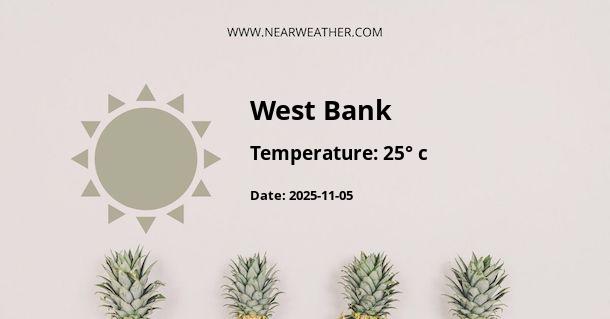Climate and Weather in West Bank, Palestine
The West Bank is a landlocked territory located in the Middle East, bordered by Israel to the east, and Jordan to the east and south. It has a Mediterranean climate with hot, dry summers and mild, wet winters. The climate in the West Bank is influenced by its location, topography, and the Mediterranean Sea. In this article, we will explore the climate and weather patterns in the West Bank throughout the year.
Summer (June to August)
Summers in the West Bank are characterized by hot and dry weather. The temperatures during this season can reach an average high of 32°C (90°F) during the day, with occasional heatwaves pushing the mercury even higher. The nights are relatively cooler, with temperatures dropping to around 19°C (66°F). The summer season in the West Bank is also marked by low humidity, making the heat more bearable.
The lack of significant rainfall during the summer months contributes to the dryness of the region. The average precipitation during this season is minimal, with less than 1 mm in total. It is important to note that the West Bank experiences occasional dust storms, known as "Hamsin," during the summer months. These storms bring strong winds and reduced visibility, which can impact daily life in the region.
Autumn (September to November)
Autumn in the West Bank is characterized by milder temperatures and decreasing heat. The average daytime temperatures during this season range from 24°C (75°F) in September to 17°C (63°F) in November. The nights become cooler, with temperatures dropping to around 11°C (52°F) in November.
Precipitation begins to increase during the autumn months, bringing relief from the dry summer. The average rainfall during this season ranges from 15 mm in September to 70 mm in November. The autumn rains contribute to the greening of the landscape and the growth of vegetation in the region.
Winter (December to February)
Winters in the West Bank are mild and relatively wet. The average daytime temperatures during this season range from 12°C (54°F) in December to 16°C (61°F) in February. The nights can be chilly, with temperatures dropping to around 6°C (43°F) in December.
The winter months bring the majority of the annual rainfall to the West Bank. The average precipitation during this season ranges from 100 mm in December to 150 mm in February. The rainfall contributes to the replenishment of groundwater resources and supports agricultural activities in the region.
Snowfall is not uncommon in the higher elevations of the West Bank, particularly in areas like Hebron and Nablus. These snowfalls are usually light and temporary, but they add to the beauty of the landscape and attract tourists.
Spring (March to May)
Spring in the West Bank is a beautiful season characterized by pleasant temperatures and blooming flowers. The average daytime temperatures during this season range from 17°C (63°F) in March to 24°C (75°F) in May. The nights become milder, with temperatures ranging from 10°C (50°F) in March to 16°C (61°F) in May.
The spring months also bring some rainfall, with an average precipitation ranging from 70 mm in March to 30 mm in May. The rains support the growth of crops and contribute to the overall fertility of the region.
Conclusion
The West Bank experiences a Mediterranean climate with hot, dry summers and mild, wet winters. The region's climate is influenced by its location and topography, as well as the nearby Mediterranean Sea. The summer months are characterized by high temperatures and low precipitation, while the winter months bring milder temperatures and the majority of the annual rainfall. Autumn and spring provide transitional periods with milder temperatures and moderate rainfall. Understanding the climate and weather patterns in the West Bank is essential for planning activities and enjoying the beauty of the region throughout the year.
A - West Bank's Latitude is 31.666670 & Longitude is 35.250000.
A - Weather in West Bank is 25° today.
A - Climate Conditions in West Bank shows broken clouds today.
A - Humidity in West Bank is 33% today.
A - Wind speed in West Bank is 6.41 km/h, flowing at 359° wind direction. today.
